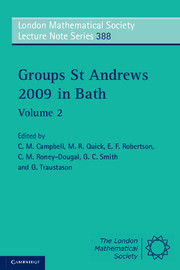Book contents
- Frontmatter
- Contents
- Introduction
- Algorithms for matrix groups
- Residual properties of 1-relator groups
- Words and groups
- The modular isomorphism problem for the groups of order 512
- Recent progress in the symmetric generation of groups
- Discriminating groups: a comprehensive overview
- Extending the Kegel Wielandt theorem through π-decomposable groups
- On the prime graph of a finite group
- Applications of Lie rings with finite cyclic grading
- Pronormal subgroups and transitivity of some subgroup properties
- On Engel and positive laws
- Maximal subgroups of odd index in finite groups with simple classical socle
- Some classic and nearly classic problems on varieties of groups
- Generalizations of the Sylow theorem
- Engel groups
- Lie methods in Engel groups
- On the degree of commutativity of p-groups of maximal class
- Class preserving automorphisms of finite p-groups: a survey
- Symmetric colorings of finite groups
- References
Generalizations of the Sylow theorem
Published online by Cambridge University Press: 05 July 2011
- Frontmatter
- Contents
- Introduction
- Algorithms for matrix groups
- Residual properties of 1-relator groups
- Words and groups
- The modular isomorphism problem for the groups of order 512
- Recent progress in the symmetric generation of groups
- Discriminating groups: a comprehensive overview
- Extending the Kegel Wielandt theorem through π-decomposable groups
- On the prime graph of a finite group
- Applications of Lie rings with finite cyclic grading
- Pronormal subgroups and transitivity of some subgroup properties
- On Engel and positive laws
- Maximal subgroups of odd index in finite groups with simple classical socle
- Some classic and nearly classic problems on varieties of groups
- Generalizations of the Sylow theorem
- Engel groups
- Lie methods in Engel groups
- On the degree of commutativity of p-groups of maximal class
- Class preserving automorphisms of finite p-groups: a survey
- Symmetric colorings of finite groups
- References
Summary
Abstract
Let π be a set of primes. Generalizing the properties of Sylow p-subgroups, P.Hall introduced classes Eπ, Cπ, and Dπ of finite groups possessing a π-Hall subgroup, possessing exactly one class of conjugate π-Hall subgroups, and possessing one class of conjugate maximal π-subgroups respectively. In this paper we discuss a description of these classes in terms of a composition and a chief series of a finite group G.
Introduction
In 1872, the Norwegian mathematician L. Sylow proved the following outstanding theorem.
Theorem 1.1 (L. Sylow [76])Let G be a finite group and p a prime. Assume |G| = pαm and (p, m) = 1. Then the following statements hold:
(E) G possesses a subgroup of order pα (the, so-called, Sylow p-subgroup);
(C) every two Sylow p-subgroups of G are conjugate;
(D) every p-subgroup of G is included in a Sylow p-subgroup.
A natural generalization of the concept of Sylow p-subgroups is the notion of π-Hall subgroups. We recall the definitions. Let G be a finite group and π be a set of primes. We denote by π′ the set of all primes not in π, by π(n) the set of all prime divisors of a positive integer n and for a finite group G we denote π(|G|) by π(G). A positive integer n with π(n) ⊆ π is called a π-number and a group G with π(G) ⊆ π is called a π-group.
- Type
- Chapter
- Information
- Groups St Andrews 2009 in Bath , pp. 488 - 519Publisher: Cambridge University PressPrint publication year: 2011
References
- 3
- Cited by

